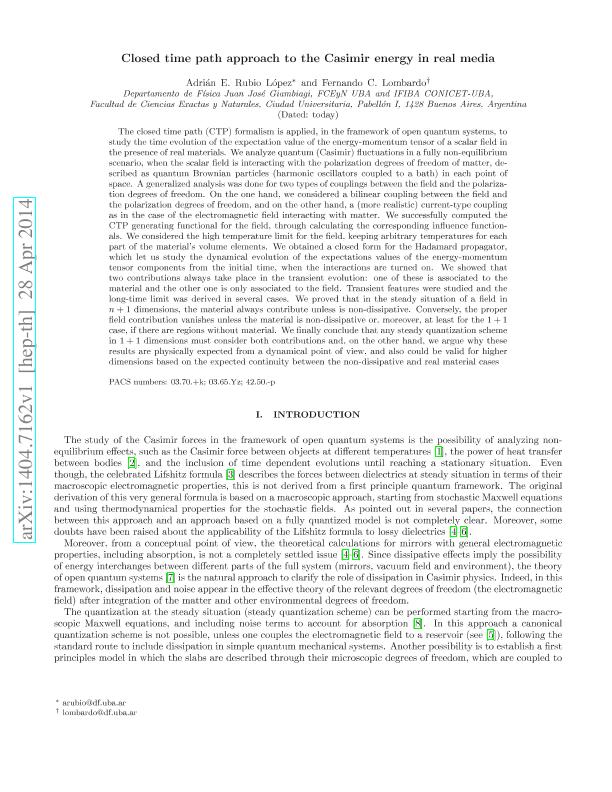Artículo
Closed-time-path approach to the Casimir energy in real media
Fecha de publicación:
05/2014
Editorial:
American Physical Society
Revista:
Physical Review D
ISSN:
0556-2821
Idioma:
Inglés
Tipo de recurso:
Artículo publicado
Clasificación temática:
Resumen
The closed-time-path (CTP) formalism is applied, in the framework of open quantum systems, to study the time evolution of the expectation value of the energy-momentum tensor of a scalar field in the presence of real materials. We analyze quantum (Casimir) fluctuations in a fully nonequilibrium scenario, when the scalar field is interacting with the polarization degrees of freedom of matter, described as quantum Brownian particles (harmonic oscillators coupled to a bath) at each point of space. A generalized analysis is done for two types of couplings between the field and the polarization degrees of freedom. On the one hand, we consider a bilinear coupling between the field and the polarization degrees of freedom, and on the other hand, a (more realistic) current-type coupling as in the case of the electromagnetic field interacting with matter. We successfully compute the CTP generating functional for the field through calculating the corresponding influence functionals. We consider the high-temperature limit for the field, keeping arbitrary temperatures for each part of the material’s volume elements. We obtain a closed form for the Hadamard propagator, which allows us to study the dynamical evolution of the expectations values of the energy-momentum tensor components from the initial time when the interactions are turned on. We show that two contributions always take place in the transient evolution: one is associated with the material, and the other is only associated with the field. Transient features are studied and the long-time limit is derived in several cases. We prove that in the steady situation of a field in n þ 1 dimensions, the material always contributes unless it is nondissipative. Conversely, the proper field contribution vanishes unless the material is nondissipative or—at least for the 1 þ 1 case—if there are regions without material. We finally conclude that any steady quantization scheme in 1 þ 1 dimensions must consider both contributions and, on the other hand, we argue why these results are physically expected from a dynamical point of view, and also could be valid for higher dimensions based on the expected continuity between the nondissipative and real-material cases.
Palabras clave:
Nonequilibrium Quantum Field Theory
,
Casimir Effect
,
Open Quantum System
Archivos asociados
Licencia
Identificadores
Colecciones
Articulos(IFIBA)
Articulos de INST.DE FISICA DE BUENOS AIRES
Articulos de INST.DE FISICA DE BUENOS AIRES
Articulos(OCA CIUDAD UNIVERSITARIA)
Articulos de OFICINA DE COORDINACION ADMINISTRATIVA CIUDAD UNIVERSITARIA
Articulos de OFICINA DE COORDINACION ADMINISTRATIVA CIUDAD UNIVERSITARIA
Citación
Rubio Lopez, Adrian Ezequiel; Lombardo, Fernando Cesar; Closed-time-path approach to the Casimir energy in real media; American Physical Society; Physical Review D; 89; 10; 5-2014; 1-26; 105026
Compartir
Altmétricas




